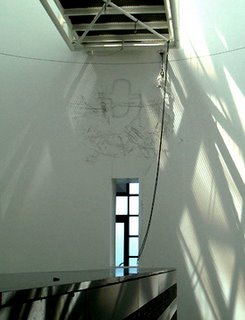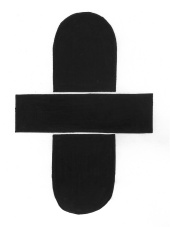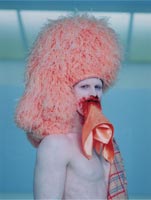Thoughts on Matthew Barney:
I recently had the opportunity to see the new Matthew Barney exhibit at the SFMOMA. I had missed his previous Cremaster Cycle exhibit, much to my regret, and was excited that this had come to
This multimedia exhibit was called “Drawing Restraint,” and involved a feature length film and several rooms filled with plastic castings, with drawings and short videos. Barney’s theme again derives from his experience with sports: Restraint on muscles affect and shapes them. Exercise transforms the body. And as always, Barney uses his body directly as part of the art.
At the opening Barney climbed up the 100+ foot atrium at SFMOMA,  using a climbing rope and clipping himself on anchors along the wall. He climbed underneath a walkway and hanging suspended by the rope, began to draw on a high wall. He has done an original drawing in a similar way at each Restraint exhibition. This climbing also reminded me of the five levels of climbing from Cremaster 3, where Barney also employed a harness and climbing equipment as he scaled levels in the Guggenheim.
using a climbing rope and clipping himself on anchors along the wall. He climbed underneath a walkway and hanging suspended by the rope, began to draw on a high wall. He has done an original drawing in a similar way at each Restraint exhibition. This climbing also reminded me of the five levels of climbing from Cremaster 3, where Barney also employed a harness and climbing equipment as he scaled levels in the Guggenheim.
One of his works echoed the idea of drawing with encumbrance. He combined several heavy free weight plates with a pen, then evidently tried to make a drawing by pushing the weights.
The theme of transformation was echoed in a sculpture of ambergris. Ambergris is regurgitated Sperm whale digestive material. It is thought that it may help passage of hard squid skeletons out of the whale. Ambergris is highly prized in the perfume industry; in fact, beachcombers can expect to reap about $8000 per pound of the rare substance.
Ambergris must remain at sea for approximately a decade to be valuable. During this time it loses its initial fecal odor and develops a sweet fragrance. So Barney’s theme of transformation is echoed in a huge, 20 foot+ sculpture of faux ambergris using glued squid shells. This sculpture also plays a role in the film Restraint 9.
No Matthew Barney exhibit would be complete without something made with petroleum jelly. In this case, Barney filled an enormous mold with petroleum jelly and allowed it to settle once solidified. The resulting shape was then cast in white plastic. The textures and fractures on this were very interesting.
The Japanese whaling ship featured in the film is the Nisshin Maru, which in 1999 was involved in a collision with a Greenpeace vessel. This event is mentioned in one of the rare moments of dialogue in Barney’s film, in which a member of the crew discusses the mark (both literal and figurative) left by the collision. The collision can therefore be seen as itself a kind of transformative event, altering the shape of the boat and bringing to worldwide attention in a dramatic way the fact that the Japanese still practice whaling, an unnecessary and barbaric fact that should be a source of great shame to the Japanese naton.
Barney chooses not to address the whaling issue. However, as the film progresses The Field sculpture dissolves on the deck of the Nisshin Maru, looking remarkably like a whale being cut apart by flensing knifes. Flensing also takes place in the scene between Barney and his wife Björk.
Barney and Björk arrive on the ship separately, and are immediately cleaned in preparation for a tea ceremony; Barney’s scraggly beard is shaven and Björk is bathed, and they are each dressed in elaborate costumes, transforming them. Following the ceremony, they embrace and lovingly cut each other with flensing knives until they are transformed into whales. Indeed, this very act is happening on a whaling ship which transforms whales into oil—much like the petroleum jelly that gradually fills the room until Barney and Björk are swimming in it.
In sum, this was a very thought-provoking exhibition by that most rare and unique of persons: An important contemporary artist.
